Ask questions which are clear, concise and easy to understand.
Ask QuestionPosted by Piyush Barde 5 years, 1 month ago
- 1 answers
Posted by Rohan Raj 5 years, 1 month ago
- 2 answers
Yogita Ingle 5 years, 1 month ago
Law of Malus : According to Malus, when completely plane polarised light is incident on the analyser, the intensity I of the light transmitted by the analyser is directly proportional to the square of the cosine of angle between the transmission axes of the analyser and polarizer i.e {tex}I \alpha co{{s}^{2}}$$\theta .{/tex}
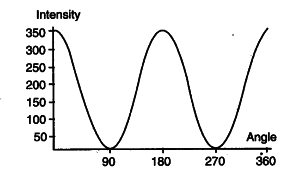
Posted by Ramkesh Meena 5 years, 1 month ago
- 0 answers
Posted by Arif Khan 5 years, 1 month ago
- 3 answers
Posted by Ashish Sharma 5 years, 1 month ago
- 2 answers
Yogita Ingle 5 years, 1 month ago
VAN DE GRAAFF Generator
Van de graaff generator is used to generate high voltages of the order of a few million volts. This results in generation of large electric fields for experimental purposes.
Principle

- The inner sphere has a higher potential than outer if the charge q is positive.
- If the two spheres are connected through a wire, the charge will flow from high to low potential.
Posted by Anushka Rayzada 5 years, 1 month ago
- 1 answers
Utkarsh Patel 5 years, 1 month ago
Posted by Ashish Sharma 5 years, 1 month ago
- 5 answers
Hitanshu Tyagi 5 years, 1 month ago
Devansh Chouhan 5 years, 1 month ago
Yogita Ingle 5 years, 1 month ago
An electric dipole is a pair of equal and opposite point charges q and –q, separated by a distance of 2a.
- Direction from –q to q is the direction of the dipole.
- The mid-point of locations of –q and q is called the center of the dipole.
- Total charge of an electric dipole is zero but since the charges are separated by some distance the electric field do not cancel out.
- Dipole moment is the mathematical product of the separation of the ends of a dipole and the magnitude of the charges (2a x q).
Praveen Praveen 5 years, 1 month ago
Posted by Ishika Sharma 5 years, 1 month ago
- 2 answers
Yogita Ingle 5 years, 1 month ago
Electrostatic force depends on magnitude of charges, distance between the charges and material between them.
The dielectric constant does not change because, it is a constant. But the relative permittivity can vary and the force is inversely proportional to it.
So, as permittivity of medium increases, the magnitude of force decreases
Posted by Ashutosh Bind 5 years, 1 month ago
- 3 answers
Sneha Kakadiya 5 years, 1 month ago
Posted by Jass Saggu 5 years, 1 month ago
- 3 answers
Posted by Mishti ???? 5 years, 1 month ago
- 4 answers
Posted by Devil ? 5 years, 1 month ago
- 1 answers
Gaurav Seth 5 years, 1 month ago
(a)
Radio waves have wavelengths of 1mm to 100km. Hence, 21cm lies at short wavelength end of radio waves.
(b)
Radio waves belong to the shortest wavelength in the electromagnetic spectrum
Posted by Aditya Yadav 5 years, 1 month ago
- 3 answers
Insha Khalid 5 years, 1 month ago
Yogita Ingle 5 years, 1 month ago
Electric Flux
Electric flux is the measure of flow of the electric field through a given area. Electric flux is proportional to the number of electric field lines going through a normally perpendicular surface.

Tanya ?? 5 years, 1 month ago
Posted by Vaishnavi Mohan 5 years, 1 month ago
- 5 answers
Ѕαи∂Єєρ Chowdary 5 years, 1 month ago
Posted by Ghanshayam Sharma 5 years, 1 month ago
- 2 answers
Arif Khan 5 years, 1 month ago
Posted by Krish Phutela 5 years, 1 month ago
- 2 answers
Yogita Ingle 5 years, 1 month ago
The electrons revolve around the nucleus with a fixed energy level. These electrons cannot cross this energy level until an extra energy is supplied even if the energy is supplied to the system. The nucleus has an equal amount of oppositely charged protons at static position which makes effective nuclear charge positive. But when electrons get attracted to the nucleus, the nuclear charge is balanced by the repulsion force applied by other electrons present in the different sub shells resulting into moving them far from the nucleus. Hence after gaining extra energy, the electrons can jump to higher energy level. And after losing energy, they come to ground level. But do not fall into the nucleus.
Also every revolving particle radiates energy and should fall into nucleus.
But as Niel’s Bohr stated , only certain special orbits known as discrete orbits of electrons are allowed inside the atom and while revolving in discrete orbits, the electrons do not radiate energy. Hence can not fall into the nucleus.
Posted by Richa Pandey 5 years, 1 month ago
- 3 answers
Devansh Chouhan 5 years, 1 month ago
Insha Khalid 5 years, 1 month ago
Yogita Ingle 5 years, 1 month ago
According to Gauss’s law, the total of the electric flux out of a closed surface is equal to the charge enclosed divided by the permittivity. The total electric flux through a closed surface is zero if no charge is enclosed by the surface.
- Gauss’s law is true for any closed surface, no matter what its shape or size.
- The term q on the right side of Gauss’s lawincludes the sum of all charges enclosed by the surface. The charges may be located anywhere inside the surface.
- In the situation when the surface is so chosen that there are some charges inside and some outside, the electric field [whose flux appears on the left side of Eq. (1.31)] is due to all the charges, both inside and outside S. The term q on the right side of Gauss’s law, however, represents only the total charge inside S.
- The surface that we choose for the application of Gauss’s law is called the Gaussian surface. The Gaussian surface can pass through a continuous charge distribution.
- Gauss’s law is useful for the calculation of the electrostatic field for a symmetric system.
- Gauss’s law is based on the inverse square dependence on distance contained in the Coulomb’s law. Any violation of Gauss’s law will indicate departure from the inverse square law.


Posted by Ritika Goswami 5 years, 1 month ago
- 1 answers
Gaurav Seth 5 years, 1 month ago
In the past there has been a debate over the nature of light. If, it exhibits wave nature or particle nature. And, inorder to establish the nature of light, various theories about the nature of light have been proposed from time to time.
Some of the main theories are as follows:
1. Corpuscular theory of light: Newton, the great among the greatest, proposed in 1675 A.D. that light consists of tiny particles called corpuscles which are shot out at high speed by a luminous object. This theory could explain the reflection, refraction and rectilinear propagation of light.
2. Wave theory of light wave: In 1678, Dutch scientist Christian Huygens, suggested that light travels in the form of longitudinal waves just as sound propagates through air. Later on, Fresnel and Young showed that light propagates as a transverse wave. This successfully explained the reflection, refraction as well as interference, diffraction and polarisation of light waves.
3. Electromagnetic nature of light waves: In 1873, Maxwell suggested that light propagates as electric and magnetic field oscillations. These are called electromagnetic waves which require no medium for their propagation. Also, these waves are transverse in nature.
4. Planck’s quantum theory of light: According to Max Planck, light travels in the form of small packets of energy called photons. In 1905, Albert Einstein used this theory to explain photoelectric effect (emission of electrons from a metal surface when light falls on it).
5. De-Broglie's hypothesis: De Broglie suggested that light has a dual nature, i.e., it can behave as particles as well as waves.
So, we see that in phenomena like interference, diffraction and polarisation, light behaves as a wave while in photoelectric effect, it behaves a particle.
Posted by Sneha Panwar 5 years, 1 month ago
- 1 answers
Jahnavi Laller 5 years, 1 month ago
Posted by Anushka Singh 5 years, 1 month ago
- 1 answers
Gaurav Seth 5 years, 1 month ago
Using Biot-Savart's law:
Here, the length of wire segment is so small compared to the distance of the point, we can use any of the 3 formulas above to find dB or B.
Using (3) is difficult as finding θ1 and θ2 and their Cosine is tough. So use either (1) or (2) directly.
Using (1):
dB = 10⁻⁷ units * 5A * 0.01 m * Sin 45⁰ / (2 m) ² Tesla
= 1.77 * 10⁻⁷ Tesla
 <button role="button" title="enlarge image"></button>
<button role="button" title="enlarge image"></button>
<button role="button" title="enlarge image"></button>
<button role="button" title="rotate image"></button>
<button role="button" title="rotate image"></button>
Posted by Anushka Singh 5 years, 1 month ago
- 2 answers
Gaurav Seth 5 years, 1 month ago
The time period is given as
T = 2πm / Bq
where
mass of the electron, m = 9.1 X 10-31 kg
magnetic field strength, B = 0.2 mT = 0.2 X10-3 T
charge on the electron, q = 1.6 X10-19 C
so,
T = (2 X3.14 X 9.1 X 10-31) / (0.2 X10-3 X 1.6 X10-19)
or
T = (57.148/0.32) X 10-9
thus, the time period will be
T = 1.785 X 10-7 secs.
Posted by Himanshu Sharma 5 years, 1 month ago
- 1 answers
Gaurav Seth 5 years, 1 month ago
Optical fibres are fabricated such that light reflected at one side of inner surface strikes the other at an angle larger than the critical angle. Even if the fibre is bent, light can easily travel along its length. Thus, an optical fibre can be used to act as an optical pipe. They are made up of plastic.
Posted by Himanshu Sharma 5 years, 1 month ago
- 2 answers
Yogita Ingle 5 years, 1 month ago
In the figure, when a charge q is placed at corner A of the cube, it is being shared equally by 8 cubes
∴ total flux through the faces of the given cube=q/8ε0
Ashwani Kumar Singh 5 years, 1 month ago
Posted by Kavitha Senthil 5 years, 1 month ago
- 1 answers
Gaurav Seth 5 years, 1 month ago
(i) The working of optical fiber is based on total internal reflection. Statement: When a light ray goes from denser to rarer medium at an angle greater than critical angle, the ray is totally reflected in first (denser) medium. This phenomenon is called total internal reflection.
(ii) Conditions: (a) Ray of light must go from denser medium to rarer medium. (b) Angle of incdience must be greater than critical angle (i.e.,i > C).v
Posted by Alok Pathak 5 years, 1 month ago
- 1 answers
Arpit Singh Dangi 4 years, 9 months ago
Posted by Deepanshu Khola 5 years, 1 month ago
- 0 answers

myCBSEguide
Trusted by 1 Crore+ Students

Test Generator
Create papers online. It's FREE.

CUET Mock Tests
75,000+ questions to practice only on myCBSEguide app
 myCBSEguide
myCBSEguide
Yogita Ingle 5 years ago
Mirror formula is the relationship between object distance (u), image distance (v), and focal length.

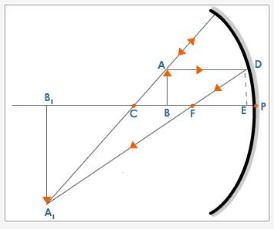
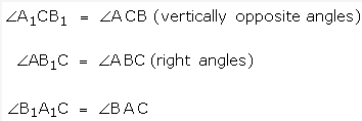

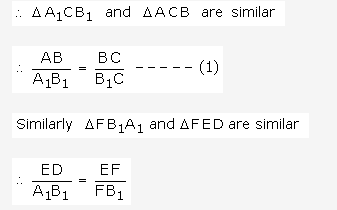


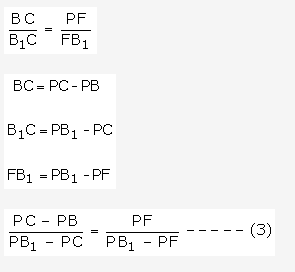
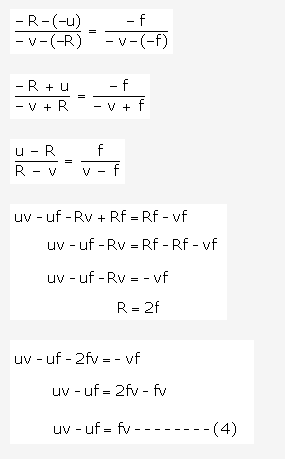
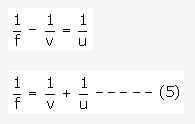
</article>Derivation
The figure shows an object AB at a distance ‘u’ from the pole of a concave mirror. The image A1B1 is formed at a distance ‘v’ from the mirror. The position of the image is obtained by drawing a ray diagram.
Consider the D A1CB1 and D ACB
[when two angles of D A1CB1 and D ACB are equal then the third angle
But ED = AB
From equations (1) and (2)
If D is very close to P then EF = PF
But PC = R, PB = u, PB 1 = v, PF = f
By sign convention
PC = -R, PB = -u, PF = -f and PB 1 = -v
Equation (3) can be written as
Dividing equation (4) throughout by uvf we get
Hence, equation (5) gives the mirror formula.
3Thank You